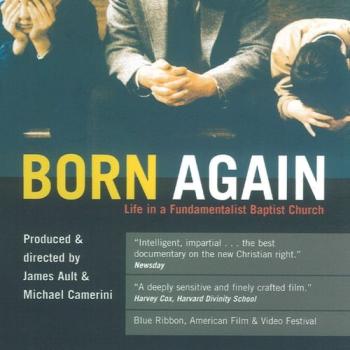Defining “Evangelical”: Why It’s Necessary and Impossible
Some years ago Presbyterian publisher Westminster John Knox Press asked me to write a volume for a theological handbook series. Mine was to be The Westminster Handbook to Evangelical Theology. It was published in 2004. This was one of the most labor-intensive writing projects I’ve ever undertaken and completed. In published form it contains 328 double column pages. Although it has not been one of my best-selling books (that would be Finding God in the Shack), it received good reviews including positive endorsements (published on its back cover) from Randall Balmer, Gary Dorrien, and David Bebbington. Here is what one of my blog’s frequent visitors said of it recently:
“I am almost finished with your Westminster Handbook of Evangelicalism. Who would have thought that a handbook that is essentially a dictionary would be a great read, but I have enjoyed every entry. I think you have acheived a much better integration of the material than most dictionaries/handbooks with multiple authors. As usual, the work reflects a very ecumenical perspective without underplaying the important differences. I especially appreciated how you brought out J.I. Packer’s “paradox” view of God’s sovereignty as a kind of middle path between Calvinism and Arminianism, and I think you have clarified the precise difference between Semi-Pelagianism and Classical Arminianism as well as I have ever seen it done. Your works are all self-contained courses in themselves, and I think you have a rare talent for being able to achieve this in a truly balanced way. Most authors just seem to have to bash their opponents somewhere along the line but you never do that. Great work, Roger, and many thanks for providing these tools. They are models of clarity and balance.”
One of the reasons I accepted the publisher’s invitation and assignment was because I didn’t trust just anyone to write such a book. I feared if I didn’t do it, someone else who defines “evangelical” differently would do it! And by “differently” I don’t mean “slightly” or even “somewhat,” I mean “radically.”
As anyone who has come here frequently and long knows, there is a huge struggle over the meaning of “evangelical.” Many evangelical spokespersons and leaders desperately want to define it by putting their preferred boundaries around it so that they can control public perception of it. Many of my interlocutors have asked me very sincerely why I care about this struggle. Why not “let them have it?” (Meaning by “it” the ability to define “evangelical.”) Well, the reason is obvious to anyone inside the movement. The struggle is for the hearts and minds of influential evangelical decision makers—publishers, editors, denominational executives, college, university and seminary administrators, etc. Having been on the inside of the movement all my life and having been close to such influential people in it, I can tell you that many of the movements’ movers and shakers make decisions based largely on their perception of the meaning of “evangelical.” Is so-and-so “truly evangelical?” She might get hired or not based on that perception. He might get published or not based on it. A great deal of money flows around within evangelicalism and it flows in the direction of someone’s perceived “authentic evangelical” status. For the past fifty years students have flocked to evangelical colleges, universities and seminaries, often making their decisions based on the schools’ reputations as either evangelical or not.
I’m not saying this tendency is right; I’m just explaining why “ownership” of the label is such a battleground. “We’re more evangelical than they” (and often “than anyone else”) is the claim of many executives and administrators.
A few years ago a group of influential evangelical scholars began a several years long project to define “evangelical.” I attended some of their sessions and was at the final one where it became clear that there was no working consensus about the matter. Frustration filled the room. Why couldn’t a diverse group of evangelical scholars come to agreement about what the term means? The urgency was fueled, I believe, by the fact that many people who in times past would have called themselves “fundamentalists” were attempting to shift the center of the evangelical spectrum far to the right and even truncate the spectrum to exclude many individuals and organizations that they considered “doctrinally compromised” or “theologically liberal” (which almost always meant “influenced by neo-orthodoxy”). The session dragged on, tensions rose, there was a general feeling (I sensed, anyway) of disappointment. Then, a Lutheran scholar who had written on evangelicalism and evangelical theology stood at the very back of the room and said “I suggest that an ‘evangelical’ is anyone who loves Billy Graham’.” The room broke out in applause!
The product of that project was published as The Variety of American Evangelicalism first by the University of Tennessee Press and then, in 1991, by InterVarsity Press. The editors were North Park College and Seminary professor and provost Robert K. Johnston and Donald W. Dayton, professor of ethics at Northern Baptist Theological Seminary. (Both men moved on to other institutions since then.) The volume portrayed evangelicalism as a very large and broad tent, inclusive of a great diversity of traditions and affiliations.
Partly, I suspect, in response to those broad definitions (or descriptions) of “evangelical” and “evangelicalism,” some evangelicals began attempting to narrow those concepts down by identifying “evangelical boundaries”—as if such a large and diverse movement could be confined within walls. Many wanted to identify inerrancy as such a boundary such that anyone who does not at least pay lip service to it cannot be legitimately evangelical. Some of the same wanted to add monergism to the definition of evangelical such that anyone who does not believe in irresistible grace cannot be authentically evangelical.
Throughout the 1990s I became increasingly involved in these debates. I knew I was authentically evangelical; I had grown up in the thick of the movement and still believed in its basic tenets and held its basic convictions and yet realized I was among the many targets of those who wanted to define many of us out of the movement. They wanted to rip my wallet out of my pocket (so to speak) and take out my evangelical credentials and rip them up and burn the pieces. Of course, I wasn’t nearly as much of a target as some of my friends. So I came to their defenses. Then I became even more of a target (than I had been).
Sometime in the late 1990s I was invited to speak to the presidents of the thirteen colleges of the Christian College Consortium—all self-identified evangelical institutions . They were holding one of their annual meetings and invited me to talk to them about evangelicalism. I knew they were particularly interested in the issue of evangelical “boundaries.” I also knew all of them were under pressure from constituents, many of them with “deep pockets,” to bow to conservatives who, through their publications, wanted to label many of us as what Luther called “false brethren.” I gave my presentation, which argued for a relatively broad and inclusive definition of “evangelicalism,” using the same hallmarks as Mark Noll and David Bebbington (biblicism, conversionism, crucicentrism, and activism). I was supposed to answer question after my presentation, but the presidents had few questions of me. They fell into polite but pointed argument among themselves about the meaning of “evangelical.” What became clear to me as I listened was that two of the presidents very much wanted to define it in terms of creedal orthodoxy, with very narrow boundaries, while others insisted on keeping it broad and inclusive. What was playing out before my eyes and ears was my own description of two approaches to defining “evangelical” and “evangelicalism”—one centered and one bounded. To two of the presidents, I discerned, a person is either “in” or “out.” It was for them a matter of black and white. They did not seem to want to admit degrees of “evangelicalness.” To others (some didn’t express opinions but only asked questions), “evangelicalness” is a matter of degrees—a spectrum. (A couple of presidents seemed to want to abandon the concept altogether but everyone there knew that wasn’t possible for them.)
That’s just once case study of problems top level evangelicals have with the concept. I’ve been in many meetings where the same issues have divided the participants—sometimes in very harsh tones.
It seems necessary to at least attempt to define “evangelical” and “evangelicalism.” At the same time it seems impossible—at least in terms of reaching consensus. Noll’s and Bebbington’s four hallmarks approach is helpful, but then, among those who use them, the question arises about whether they constitute the “center” of a set or its boundaries. And, especially if boundaries, how are they to be defined? What, for example, constitutes “biblicism?” Is inerrancy part and parcel of true biblicism? Most boundary seekers would say yes; most center seekers would say no. The moment you define biblicism as including inerrancy you set a boundary. But then the problem becomes patrolling it and keeping the right people “in” and the wrong people “out.” Who does that? There’s no evangelical magisterium or headquarters, so what exactly is the function of boundaries?
Some boundary people answer that identifying and keeping clear evangelical boundaries has practical functions. It helps know whom to hire or publish or listen to. But, of course, especially with regard to the first two functions, everyone knows and admits that organizations have boundaries. That’s not in debate. But just because an organization sets a boundary doesn’t mean that’s a boundary for all evangelicals. A case in point is Carl F. H. Henry, a founder of the Evangelical Theological Society. He and they set a boundary for their organization that includes biblical inerrancy. But Henry himself stoutly denied that belief in inerrancy is a boundary for evangelicalism as a whole. He considered non-inerrantist evangelicals inconsistent but not thereby non-evangelical.
As for the third function, knowing whom to listen to, that seems to me what this is mainly about. But, of course, all it means is that someone doesn’t want someone else (usually students and administrators) to listen to another. But, of course, all that is happening, when someone declares someone else not truly evangelical and therefore unworthy of being taken seriously as an evangelical thinker, for example, is expressing an opinion.
Recently I’ve been doing a lot of reading about Pietism. And I’ve written some articles and given some talks about Pietism. (My most recent article is on Pentecostalism and Pietism in Pneuma, the journal of the Society for Pentecostal Studies. It’s a version of a lecture I gave at Regent University in North Carolina about a year ago.) Debate about defining Pietism has heated up again. It was hot in the early eighteenth century. Then and now one point of disagreement among scholars is whether Count Zinzendorf, leader of the Moravians, should be considered a pietist or not. Historians of the movement disagree sharply about its boundaries.
It has always seemed self-evident to me that movements cannot have boundaries. In fact, secretly, only to myself, I have long considered people who think movements can have boundaries either disingenuous or sociologically ignorant. Organizations have boundaries; movements do not. It’s self-evident. Movements have centers, not boundaries.
Just yesterday I came across a reference to and discussion of a scholar I’ve never heard of before whose work helps a great deal—in explaining what movements like Pietism and evangelicalism are and are not and how to describe them when clear definition is impossible. The scholar I refer to is George Lakoff and the book where he puts forth his idea of prototypical defining of categories (such as movements) is Women, Fire, and Dangerous Things: What Categories Reveal about the Mind (University of Chicago Press, 1997). The scholar who pointed me to Lakoff and his ideas is Peter James Yoder (whose excellent chapter in The Pietist Impulse in Christianity is entitled “’Rendered Odious’ as Pietists: Anton Wilhelm Böhme’s Conception of Pietism and the Possibilities of Prototype Theory”).
According to Lakoff, according to Yoder (I have yet to read Lakoff for myself), categories such as Pietism and evangelicalism (Yoder’s and my examples, not Lakoff’s) can only be defined in terms of “prototypical members.” Yoder summarizes Lakoff’s suggestion this way: “Some members of a category are more prototypical than others. As individuals or groups construct categories, they show a propensity to see some category members as better representatives of the grouping than others. At the same time, these categories tend to have “fuzzy edges,” as they stand for several conceptions of the same grouping.” (The Pietist Impulse in Christianity, The Princeton Monograph Series, ed., Christian Collins Winn, et al., [Pickwick, 2011], p. 24) Such categories admit degrees of membership and they are defined centrally, that is in terms of a center constituted by the prototypes. “Prototypes merely speak of a cognitive centrality and allow for fluid, fuzzy boundaries.” (p. 24) According to Yoder, Lakoff’s theory allows one to recognize central members of categories and yet maintain fluid boundaries of the movement.” (p. 25) Yoder applies this to the debate over whether Zinzendorf should be considered part of the Pietist movement. He concludes Zinzendorf should be so considered while at the same time allowing that he may not be a member of the center of prototypes. Yoder concludes that “Prototype theory, as a mediating model, provides the ability to maintain central figures and attributes while also allowing for a more fluid boundary of the movement.” (p. 26)
Of course, I intend to obtain Lakoff’s book and read it for myself, but if Yoder is right about Lakoff’s theory, it agrees completely with my vision of evangelicalism, but it adds a dimension I have been previously lacking—“prototypes” as category-defining (and movement-defining). I use the word “defining” cautiously because many people automatically think that once you’ve defined something you’ve pinned it down so that it is either this or that. But when it comes to categories, and especially movements, “defining” means something else. It means describing in terms of prototypes and allowing for degrees of membership. (Here “membership” doesn’t mean what it means when referring to organizations with formal membership. It simply means “belonging to the category.”)
Thus, I argue that evangelicalism, like Pietism, charismatic movement, “New Age,” etc., etc. refers to a category that can only be defined in terms of prototypes that constitute a center. I would put Noll’s and Bebbington’s four hallmarks at that center and with them Jonathan Edwards and John Wesley. What did those men have in common that was not as noticeable among most of their peers in Protestant Christianity? I would say those would be biblicism, conversionism, crucicentrism and activism. And I would add to that a tendency strongly to defend the Great Tradition of Christian orthodoxy (broadly defined). Yes, to be sure, there were others who displayed the same characteristics, but they especially stand out as the prototypes of the Great Awakenings of the eighteenth century that gave birth to the modern evangelical movement.
Narrowing “evangelicalism” down to the post-WW2 “evangelical movement” (which is mostly what I write about and insist on being included in), I would again look to prototypes such as the five hallmarks above and prototypes such as Billy Graham, the National Association of Evangelicals, Harold John Ockenga, Christianity Today, Carl Henry, Fuller Seminary, Wheaton College, Billy Melvin, Eternity, World Vision, etc., etc. This way of “defining” evangelicalism and “evangelical” allows fluid boundaries (if they can be called boundaries at all!). How close to the prototypes are certain entities (people, organizations)? is the question. The Lutheran theologian was not far from right, if far at all, when he suggested that an “evangelical” (in the sense we all meant) is someone who loves Billy Graham. Of course, he did not mean, and nobody in the room assumed he meant, anyone who simply likes Billy Graham as a person is an evangelical. He meant, of course, we all knew—anyone who ardently desires to emulate Billy Graham and/or looks up to him as a prototype of modern, authentic Christianity in terms of his basic beliefs and approach to Christian life (conversion, devotion, evangelism, holiness of life, activism in seeking to change the world “for Christ,” etc., etc.).
Now, I fully realize, this approach to defining (!) “evangelical” and “evangelicalism” will never satisfy those who are out to manipulate those concepts for their own gain. But it is the most reasonable approach; all others have far greater problems.
I tend to think most people look at the world either in black and white, either-or terms or in terms of degrees, that is, appreciating ambiguity as embedded in the nature of things (or at least in our knowing). Black and white thinkers who are allergic to ambiguity will have great trouble with Lakoff’s and my approach. I simply think they are stuck in a relatively immature stage of mental development. I have no problem with their setting up organizations and patrolling their boundaries. That’s their business. I don’t have to belong to any of their organizations. But when they start treating “evangelicalism” as one and themselves as the boundary setters and patrollers I have great trouble with that. I will call them either disingenuous or uninformed.















